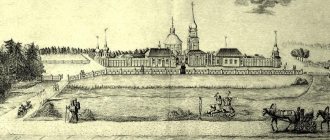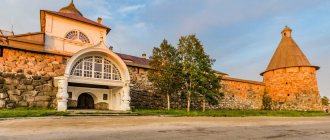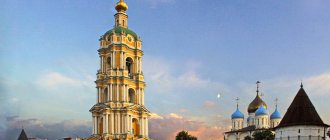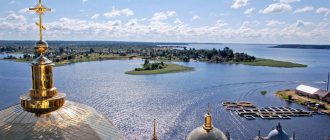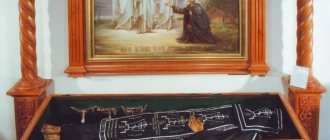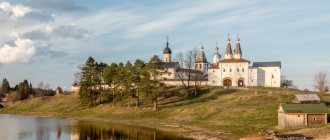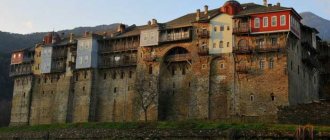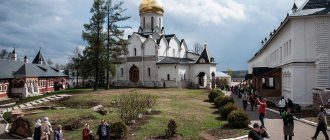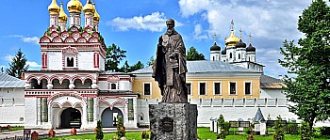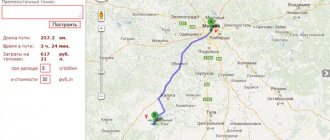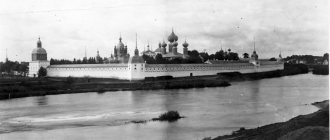Mir
Russia Vladimir Region Murom Spaso-Preobrazhensky Monastery (Murom) Map is loading…
{"format":"leaflet","minzoom":false,"maxzoom":false,"limit":50,"offset":0,"link":"all","sort":[""], "order":[],"headers":"show","mainlabel":"","intro":"","outro":"","searchlabel":"\u2026 \u0441\u043b\u0435\ u0434\u0443\u044e\u0449\u0438\u0435 \u0440\u0435\u0437\u0443\u043b\u044c\u0442\u0430\u0442\u044b","default":"","import-annotation":false,"width ":"auto","height":"350px","centre":{"text":"","title":"""link":"""lat":55.57278000000000162117430591024458408355712890625,"lon": 42.06611000000000188947524293325841426849365234375,"icon":""},"title":"","label":"","icon":"","lines":[],"polygons":[],"circles":[ ],"rectangles":[],"copycoords":false,"static":false,"zoom":8,"defzoom":14,"layers":["OpenStreetMap"],"image layers":[] ,"overlays":[],"resizable":false,"fullscreen":true,"scrollwheelzoom":true,"cluster":false,"clustermaxzoom":9,"clusterzoomonclick":true,"clustermaxradius":80, "clusterspiderfy":true,"geojson":"","clicktarget":"","showtitle":true,"hidenamespace":false,"template":"","userparam":"","activeicon": "","pagelabel":false,"ajaxcoordproperty":"","ajaxquery":"","locations":[{"text":"\u003Cb\u003E\u003Ca href=\"/palomnik/%D0% A1%D0%BF%D0%B0%D1%81%D0%BE-%D0%9F%D1%80%D0%B5%D0%BE%D0%B1%D1%80%D0%B0%D0%B6 %D0%B5%D0%BD%D1%81%D0%BA%D0%B8%D0%B9_%D0%BC%D0%BE%D0%BD%D0%B0%D1%81%D1%82%D1 %8B%D1%80%D1%8C_(%D0%9C%D1%83%D1%80%D0%BE%D0%BC)\» title=\»\u0421\u043f\u0430\u0441\u043e-\ u041f\u0440\u0435\u043e\u0431\u0440\u0430\u0436\u0435\u043d\u0441\u043a\u0438\u0439 \u043c\u043e\u043d\u0430\u0441\u0442\u04 4b\u0440\u044c (\u041c\u0443 \u0440\u043e\u043c)\»\u003E\u0421\u043f\u0430\u0441\u043e-\u041f\u0440\u0435\u043e\u0431\u0440\u0430\u0436\u0435\u043d\u044 1\u043a\u0438\u0439 \u043c\u043e\u043d\u0430\u0441\u0442\u044b\u0440\u044c (\u041c\u0443\u0440\u043e\u043c)\u003C/a\u003E\u003C/b\u003E\u003Chr /\ u003E\u003Ca href =\"/palomnik/%D0%A1%D0%B2%D0%BE%D0%B9%D1%81%D1%82%D0%B2%D0%BE:%D0%90%D0%BD%D0% BD%D0%BE%D1%82%D0%B0%D1%86%D0%B8%D1%8F\" title=\"\u0421\u0432\u043e\u0439\u0441\u0442\u0432\u043e:\u0410 \u043d\u043d\u043e\u0442\u0430\u0446\u0438\u044f\»\u003E\u0410\u043d\u043d\u043e\u0442\u0430\u0446\u0438\u044f\u003C/a\u003 E: "'\u041c\ u0443\u0301\u0440\u043e\u043c\u0441\u043a\u0438\u0439 \u0421\u043f\u0430\u0301\u0441\u043e-\u041f\u0440\u0435\u043e\u0431\u0 440\u0430\u0436\u0435\u0301 \u043d\u0441\u043a\u0438\u0439 \u043c\u043e\u043d\u0430\u0441\u0442\u044b\u0301\u0440\u044c"' (\u00ab\u0421\u043f\u0430\u0301 \u0441\u0441\u043a\ u0438\u0439 \u0447\u0442\u043e \u043d\u0430 \u0411\u043e\u0440\u0443\u0301\u00bb) \u2014 \u043c\u0443\u0436\u0441\u043a\u043e \u0439 \u043c\u043e\u043d\u0430 \u0441\u0442\u044b\u0440\u044c \u041c\u0443\u0440\u043e\u043c\u0441\u043a\u043e\u0439 \u0435\u043f\u0430\u0440\u0445\u0438\ u0438\u0420\u0443\u0441\u0441 \u043a\u043e\u0439 \u043f\u0440\u0430\u0432\u043e\u0441\u043b\u0430\u0432\u043d\u043e\u0439 \u0446\u0435\u0440\u043a\u0432\ u0438,\u0440\u0430\u0441\ u043f\u043e\u043b\u043e\u0436\u0435\u043d\u043d\u044b\u0439 \u0432 \u0433\u043e\u0440\u043e\u0434\u0435 \u041c\u0443\u0440\u 043e\u043c\u0435,\u043d\u0430 """title":"\u042 1\u043f\u0430 \u0441\u043e-\u041f\u0440\u0435\u043e\u0431\u0440\u0430\u0436\u0435\u043d\u0441\u043a\u0438\u0439 \u043c\u043e\u043d\u0430\ u0441\u0442\u044b\u0440\ u044c (\u041c\u0443\u0440\u043e\u043c)","link":"","lat":55.57278000000000162117430591024458408355712890625,"lon":42.066110000000001889 47524293325841426849365234375,"icon":""}],,"imageLayers":[]}
55.57235; 42.054055
Russia, Vladimir region, Murom, Center microdistrict
Murom, Vladimir region
Russia
Telephone
: +7 492 343-14-76
Email:
Murom Spaso-Preobrazhensky Monastery
(“Spassky on Bor”) is a monastery of the Murom diocese of the Russian Orthodox Church, located in the city of Murom, on the left bank of the Oka River.
History[edit]
Local tradition, recorded in several copies of the 16th-century monument “The Tale of the Establishment of Christianity in Murom,” connects the founding of the monastery with the Murom prince Gleb Vladimirovich (no later than 1015). The appearance of the monastery at the turn of the 10th-11th centuries is firmly established in Russian historiography, although there are other points of view on the time of the appearance of the monastery.
In the middle of the 16th century, after the successful campaign of Ivan IV the Terrible against Kazan, several stone churches were erected in Murom by order of the tsar, including the main cathedral of the Transfiguration Monastery.
The beginning of the economic prosperity of the Spassky Monastery is also associated with the name of Tsar Ivan the Terrible. Having endowed the monastery with extensive estates, the king also established a “dormitory” in it. In the Murom inventories of 1624 and 1636-1637, the monastery is listed as a “sovereign building,” which confirms the active participation in the life of the monastery of representatives of the reigning house.
In 1616, Murom was attacked by an armed Lithuanian detachment under the command of Pan Alexander Lisovsky, during which the Spassky Monastery was also damaged.
During the period of church reforms, Patriarch Nikon Murom rejected innovations for a significant time, and the Spassky Monastery was one of the strongholds of the Old Believers. The rector of the monastery, Archimandrite Anthony (1658-1662), wrote several appeals about the ordination, and also sent a petition to Tsar Alexei Mikhailovich with indications of infidelity in the correction of books under Patriarch Nikon, adding that those who are unable to expose infidelity refer to the tsar, “ like the king sings tacos.” In 1662, Archimandrite Anthony, by order of Archbishop Hilarion of Ryazan and Murom, was removed from the management of the monastery, and in February 1666 he was summoned to a council in Moscow. Despite the repentance brought, Archimandrite Anthony was exiled to the Kirillo-Belozersky Monastery.
In the 1720s, the monastery was assigned to the Ryazan Bishop's House, and the city's first educational institution was opened on its territory - a school for training priestly children.
In 1891, a stone three-story fraternal building was erected on the territory of the monastery, in which Murom vicar bishops were housed as rector: Evgeny (Mertsalov), and later Mitrofan (Zagorsky). In 1907, a house church was consecrated in the cell building in honor of the martyrs of Chersonesos.
After the revolution of 1917, the reason for the closure of the Spaso-Preobrazhensky Monastery was the accusation of its rector, Bishop Mitrofan (Zagorsky) of Murom, of complicity in the uprising that occurred in Murom on July 8-9, 1918 and led by Colonel Nikolai Pavlovich Sakharov.
In 1918-1919, the monastery's Transfiguration Cathedral continued to function as a parish church, and civilian burials took place in the monastery cemetery.
In the 1920s, the temples and premises of the monastery were inspected by representatives of the Murom museum, but already in January 1929, the Spassky Monastery was occupied by the military and partly by the NKVD department, at the same time the destruction of the monastery necropolis began, and access to its territory for civilians was stopped.
In April 1990, the public of the city of Murom addressed an open letter to the Vladimir Diocesan Administration, as well as to the Chairman of the Murom City Executive Committee V.I. Zhukov with an open letter in support of the transfer of the Murom Spassky Monastery to the Russian Orthodox Church. The idea of reviving the monastery was advocated by Academician D.S. Likhachev, who addressed a letter to Patriarch Alexy of Moscow and All Rus' on October 8, 1990.
In the spring of 1995, military unit No. 22165 left the premises of the Spassky Monastery. Hieromonk Kirill (Epifanov) was appointed vicar of the reviving monastery, who was met with complete devastation in the ancient monastery. He later recalled: “A depressing picture appeared before my eyes. The domes collapsed, the roof was demolished, the barracks were piles of bricks. At first I couldn’t even imagine how to restore all this...” But a little later that same icon of the Mother of God “Quick to Hear” returned to the monastery, and the matter got off the ground. Little by little the brethren gathered, benefactors and knowledgeable helpers appeared, and the monastery quickly rose from the ruins.
In 2000-2009, the monastery was thoroughly restored with the support of the Accounts Chamber of the Russian Federation.
Ensemble of the Spaso-Preobrazhensky Monastery
At the moment, the Spassky Monastery includes: 2 cathedrals, 4 churches, 6 chapels, fraternal and abbot's buildings, a bakery, an educational building, and a pilgrimage hotel. Despite the long and not always simple life of the monastery, its historical appearance was preserved. The buildings are made mainly of white stone, but there are also buildings made of red stone.
Cathedral of the Transfiguration
The Transfiguration Cathedral is the oldest monastery building, erected in 1555 by order of Ivan the Terrible. Despite numerous transformations, the cathedral has retained its original appearance.
The cross-domed monolithic temple is made of white stone and is topped with five black onion domes (one large central dome and four smaller domes) with openwork gold crosses resting on four pillars.
Since the cathedral could previously be used as a fortress and refuge during military raids, its architecture is distinguished by its severity. The simplicity of construction is confirmed by the absence of any interior decor. The cathedral houses parts of about 30 saints of the Orthodox Church.
Church of the Intercession of the Blessed Virgin Mary
In 1691, the white stone two-story Intercession Cathedral was erected with the financial participation of Metropolitan Barsanuphius. The cathedral is divided into upper and lower churches, which are still in use today. Later, a three-tiered hipped bell tower was added to the West side and a bell was donated. The church contains many highly revered shrines and several altars.
Church of Kirill Belozersky
The gate church of St. Kirill Belozersky was founded in the 10th century. Initially, the location of the building was different, but as a result of numerous reconstructions and rebuildings, the church was abolished, and only in 2005 it was possible to restore it.
All this time, the very first altar of the church was in the Intercession Cathedral, and by the time of consecration it was transferred to the new church of St. Cyril.
Church of St. Sergius of Radonezh
Another gate church is located on the opposite side of the monastery. The church of the “abbot of the Russian land” Sergius of Radonezh, also consecrated in 2005, has its own bell tower, where anyone can try out the ancient “bil” system.
The ringing is made not with the help of bells, but by hitting rectangular copper plates with “beaters”, which in appearance resemble hammers. The icon of Sergius of Radonezh, consecrated on the relics in the Trinity-Sergius Lavra, is located in this church.
Chapel on the site of a former cemetery
The chapel-ossuary is located on the site of a once-existing monastery cemetery, where princes, church employees, and noble citizens were previously buried. The cemetery was desecrated in the difficult years for the entire country in the 1930s, when an entire military unit arrived at the monastery and occupied its buildings and territory.
During the restoration of the territory, the ashes of people who were once buried here were excavated. For the purpose of burial, it was decided to create a chapel according to the custom adopted on Mount Athos.
Chapel of the Icon of the Mother of God “Life-Giving Spring”
The monastery chapel “Life-Giving Spring” is equipped with a font.
You can take water from the source with you, as well as plunge into the cool, blessed water. In the bathhouse there is a stone brought from Israel, from the Jordan River.
Chapel of St. George the Victorious
In 2005, another small chapel was consecrated in honor of Russian soldiers killed on the battlefield. St. George the Victorious became her patron saint.
In the chapel there is an icon of the great martyr with a particle of his relics.
Rectoral and fraternal buildings, house churches
The abbot's chambers are a two-story white stone building. This is the oldest surviving stone civil structure in Murom. The exterior of the building is a rectangular building with triangular pediments above the windows, and is characterized by simplicity and modesty.
There were storage rooms on the lower floor, and cells on the second floor. A church was also organized in the rector's house in honor of St. Basil, Bishop of Ryazan.
The building, intended for the life of the monks of the monastery, was originally wooden, but at the end of the 19th century, as a result of transformations, another floor was added, and the building itself became stone. Later a house church was opened here.
Chapel of St. Nicholas the Wonderworker and Elijah the Prophet
The Nikolo-Ilinskaya Chapel was established in the corner tower on the western side of the monastery in 1889. Reopened in 2001.
The architecture of the chapel differs from the general monastery style: it is made of red brick and has many white decorative elements. The building is crowned not with a tent, but not with a dome, as would be customary within a monastery ensemble.
Other buildings
The monastic bread of the Spasskaya monastery is known throughout Murom. The bakery employs about 30 people, supplying bakery products to various retail outlets and shops in Murom. The cozy hotel can accommodate everyone: the pilgrimage center offers various categories of rooms, as well as inexpensive meals.
Current state[edit]
In the “List of Architectural Monuments Subject to Protection as Monuments of State Significance”, the ensemble of the Spaso-Preobrazhensky Monastery includes five objects:
- Spaso-Preobrazhensky Cathedral of 1552 - small, almost square in plan, four-pillar, five-domed, three-apse;
- The refectory building with the Church of the Transfiguration, 1691, is two-story;
- Abbot's corps 1687;
- Gate Church of Kirill Belozersky 1807-10;
- Fraternal Corps 1890
Shrines of the Spaso-Preobrazhensky Monastery
- One of the most famous and especially revered shrines of the Spaso-Preobrazhensky Monastery by Orthodox people is the icon of the Mother of God “Quick to Hear.” She appeared in Murom towards the end of the 19th century and immediately became an indispensable assistant in the difficulties of the brethren of the monastery and all Murom residents. The icon was donated by the monks of the monastery of St. Panteleimon of Holy Mount Athos and is an exact copy of the miraculous image of the Mother of God of the same name, kept in the Dochiar monastery on Mount Athos. The icon is located in the Church of the Intercession, access to it is open during the opening hours of the monastery, you can leave fresh flowers near it and pray for your needs.
- Another “Athos” shrine, the icon of the Mother of God Pantanassa, resides in the Spassky monastery. Pantanassa, or in other words the All-Tsarina, was written and consecrated on Mount Athos in the Vatopedi monastery. It is believed that cancer patients who pray to this icon receive healing from their illnesses.
- Everyone can also venerate the Monk Elijah of Pechersk: a particle of the preserved relics, donated from the Holy Dormition Kiev Pechersk Lavra, is located in the left “right hand” (hand) of the statue of the holy saint, made of wood. The sculpture was created in 2006 according to the height and appearance parameters obtained as a result of scientific research of the preserved relics of the hero Ilia Muromets.
- In the chapel of the holy warrior George the Victorious there is an icon of the great martyr depicting scenes from his life. The reliquary with the particle is on the bottom of the icon.
- The image of the holy physician, Archbishop Luke (Voino-Yasenetsky) with a particle of his relics is in the same church. The canonization of Saint Luke occurred relatively recently: in 2000.
- There you can also pray to the holy spouses Peter and Fevronya in front of their icon and the ark with a particle of relics enclosed and ask for help in family matters.
- The icon of the Romanov royal family contains a stone taken from the wall of the Ipatiev house, where the Royal Passion-Bearers were brutally shot. The shrine can also be found in the Intercession Cathedral. Ensemble of the Spaso-Preobrazhensky Monastery.
Pilgrimage center
For pilgrims and traveling people, the pilgrimage center of the Transfiguration Monastery provides accommodation and food. It is designed both for people with low incomes and for more affluent tourists.
The pilgrimage hotel provides several accommodation options:
- shared room (women's room has 14 beds, men's room has 12 beds). Facilities (shower, toilet) on the floor. Cost 300 rub. per person.
- comfortable 2, 3 and 4-bed rooms with all amenities. Cost 1000 rub. per person.
- It is possible to receive VIP guests (government level).
On the ground floor there is a pilgrimage refectory. Open from 11.30 to 18.00, where you can buy lunch and/or dinner. Cost 95 rub.
You can reserve places at the pilgrimage center by calling 8-49234-3-14-76. More detailed information by phone 8-920-921-89-83, Elena Mikhailovna, director of the Pilgrimage Center.
Prices shown are for summer 2013.
If for some reason it is inconvenient for you to live on the territory of the monastery, then I recommend booking an apartment, room or hotel in the city for one or more nights. You can easily rent daily accommodation in Murom on Airbnb, or book a hotel through Booking.
The miraculous Athonite icon
The period of trials sent to the monks for their former pride lasted until the seventies of the next century, when Archimandrite Anthony (Ilyin) was appointed rector of the monastery. Finding the farm in an extremely deplorable state, this humble but very practical shepherd began by going on a pilgrimage to Saint Athos to ask for help from the Heavenly forces there.
His prayers were heard, and he returned back with the miraculous icon of the Mother of God “Quick to Hear,” which immediately attracted crowds of pilgrims and thus ensured an influx of funds into the monastery treasury. Thanks to this, over the following years it was possible to restore and bring into proper shape all the monastery buildings that had dilapidated by that time.
In addition, in 1892, near the southern wall of the monastery, a three-story brick building was built, which housed fraternal cells, and in 1907, another church was built, this time in honor of the martyrs of Chersonesos. This was the last construction undertaken at the monastery. A catastrophe was inexorably approaching, plunging the great empire into dust and tearing the Russian people away from their spiritual roots for many decades.
Monastery territory
The territory of the monastery is very well maintained. There are beautiful and neat lawns around, with a variety of flowers planted around the perimeter. In the center, almost opposite the main entrance, there is a pond in which multi-colored lotuses grow. There is an oriental-style area around it with numerous flowers, stones, and benches.
Previously, a mini-zoo with chickens, ducks, peacocks, horses and other animals was set up on the territory of the monastery. Unfortunately, in the summer of 2013, this became part of history, which pilgrims and tourists who witnessed it write about with admiration. I really hope that the animal park will be revived again in the future.
Some historical materials in this article were taken from the website of the Transfiguration Monastery www.svyto.ru.
More detailed impressions of visiting the monastery and living on its territory, as well as photographs, are here.
To get the most out of the city and its surroundings, I recommend booking an apartment, room or hotel for one or more nights. You can easily rent daily accommodation in Murom on Airbnb, or book a hotel through Booking.
You can read about other attractions of Murom and its environs, where I was able to visit, here. They are all displayed on this map.
Share in the comments which of these attractions in Murom you also visited, and also tell us about those interesting places that we missed.
Schedule of services
| Day of the week | Divine service | Time |
| Monday-Saturday | Watch. Divine Liturgy. | 07:40 |
| Vespers. Matins. | 17:30 | |
| Sunday | Watch. Early Divine Liturgy. | 08:00 |
| Watch. Late Divine Liturgy. | 10:00 | |
| Vespers. Matins. | 17:30 |
Opening hours: from 07:30 to 20:00 for pilgrims and from 10:00 to 17:00 for tourists. Each milestone of the eventful thousand-year history left its mark on the life, way of life and way of life of the monastery.
Having survived various historical eras favorable and destructive for the faith, the Transfiguration Monastery survived, maintaining its uniqueness and replenishing its spiritual and material fund with new shrines and important historical events, remaining one of the most important spiritual centers of the city of Murom.
Author: Rozova Tatyana
Article design: Vladimir the Great
Gate Church of Kirill Belozersky
The Church of St. Kirill Belozersky existed in the Spaso-Preobrazhensky Monastery since the 17th century. Until the 19th century, it was located in a different place: on the northern section of the fence (then wooden), where the gate was located at that time.
At the turn of the 18th-19th centuries, the church was abolished due to dilapidation - its altar was moved to the lower floor of the warm Intercession Church, and a memorial chapel was erected in place of its altar.
In 1807, construction of a stone fence began at the monastery. At the same time, it was decided to build the Holy Gate on its western section (in its current location). They appeared in 1810, but the construction of the new gate church of St. Kirill Belozersky dragged on for decades.
There were not enough funds (as well as, apparently, worthy motivations for these works), and it was never completed until 1917, when the revolution broke out and all monastery construction ceased for a long time. The memorial chapel, standing on the site of the altar of the first temple, was destroyed in the 1930s.
In modern times, the temple of St. Kirill Belozersky was restored. On June 22, 2005, on the day of memory of St. Kirill, it was consecrated.
Architecture
The main buildings are made in the tradition of five-domed churches, externally reminiscent of the Assumption Church of the Moscow Kremlin. The buildings were created using white and red stones, without unnecessary refinement, but attractively. The temples and chapels of the monastery are protected by the state as unique architectural monuments.
Gate Church of Kirill Beloezersky
The central building is considered to be the Transfiguration Cathedral, erected under John IV. The appearance of the building was formed over several historical periods. Initially, the cathedral was a structure on four pillars with five helmet-shaped domes, had narrow windows and wide portals. The walls were divided into segments thanks to flat pilasters. The drum cornices were decorated with teeth in two rows, and the base of the center was decorated with kokoshniks. A stone bell tower was attached to the side façade.
In mid-1839, the Transfiguration Church lost its original appearance. Architect Ya. Petrov was given the task of adding a wide refectory to the western side of the building. In addition, the heads changed their shape; from now on they became bulbous, rather than helmet-shaped. During the same period, window openings were expanded, and wide portals were narrowed to ordinary doorways. At the end of the 19th century, wooden intra-wall ties were replaced with metal ones, the cracks were covered with bricks and new plaster was laid.
In the middle of the 20th century, restoration work took place in the Transfiguration Cathedral, the goal of which was to restore its original appearance. However, the masters were unable to solve this problem.
Other buildings
The second most important religious building of the monastery is the two-story Church of the Intercession of the Virgin Mary. In the middle of the 18th century, it had five thrones, three of which were located on the second tier.
The western facade of the building has some asymmetry, resulting from the displacement of the main octagonal pillar to the north side. The Intercession Cathedral has lost its original appearance and important architectural elements due to constant reconstruction. The temple partially serves as an economic building. In contrast to the central cathedral, which stands out for its monumentality and severity, it is distinguished by its simplicity and fragility. In the middle of the 19th century, the Church of the Intercession was converted from a cold one into a heated one. In 1881, two iconostases were built on the second tier of the building, where the newly created faces of the saints were placed. The finishing of the lower floor was soon completed. Today, the Cathedral of the Intercession houses the ark with the miraculous remains of I. Muromets.
Fragment of the relics of Ilya Muromets in the Spaso-Preobrazhensky Monastery
Since the creation of the Transfiguration Monastery, there has been a bell tower on the western side of the Intercession Cathedral, which was replaced with a new one in the middle of the 18th century. In 1885, the dilapidated extension was repaired and plastered, the process was supervised by the diocesan architect. At the end of the 17th century, the abbot's chambers were erected on the territory of the monastery - a two-story house with stone vaults. In 1885, the building was completely restored: the cracked vaults, which threatened to collapse and let in the cold in winter, were replaced; The stoves, window openings, floors were redone, and the walls were plastered. The lower tier was restored in the same way. In 1885, the brethren tried to restore the monastery fence, which was completely dilapidated and falling apart. However, there was only enough money for the restoration of the western side. By the end of the 18th century. Several stone buildings appeared in the monastery: a closet for the gatekeeper, rooms for the groom and ordinary workers. The chapel-ossuary was used as a necropolis, where Russian princes, representatives of the clergy and wealthy landowners were buried for more than 900 years. After the monastery was closed, a military unit with two barracks and a training ground was placed on the site of the monastery cemetery. Between 1998 and 2005. During the restoration of the territory, many remains were discovered that were desecrated during Soviet times. To bury these relics, a chapel-ossuary was built, inside which you can see skulls and other fragments of skeletons.
Subsequent decades in the life of the monastery
The last decade of the 17th century turned out to be very fruitful in the economic life of the monastery. This happened thanks to generous donations repeatedly contributed to its treasury by Metropolitan Barsanuphius, who came from an old family of wealthy Murom merchants Chertkov. Through his generosity, a stone abbot's building was erected and the Intercession Church, which required repairs, was reconstructed.
The reign of Peter I was not filled with significant events that entered the history of the monastery. The only significant innovation during this period was the opening on its territory of the only educational institution in the city - a school where children of priests studied. Even though the number of students in it was small, its merit is obvious, since it became the first center of literacy in this vast region.
The beginning of the revival of the monastery
In 1995, on the eve of the 900th anniversary of the Spasskaya Monastery, the famous academician, keeper of Russian history D.S. Likhachev turned to Patriarch of All Rus' Alexy II with a petition for the revival of the most ancient Shrine. His words were heard. A decision was made to evict the military unit. After her departure, the chaos and destruction of the shrine took on an even more flagrant appearance. Here are photographs of what happened in 1996 and the beginning of the revival of the monastery in 1997.
The young monk, and then the abbot of the monastery, Father Kirill (Epifanov), was then given a blessing to build the monastery. In fact, it was necessary to build the monastery anew. There were no people, no money. But the main thing was God's providence. A miracle has happened. And this is surprising, because at the very beginning all this was raised through the efforts of very few people. Here is a video report from 04/26/1997 and an interview with Father Kirill, where you can see from what ruins the monastery rose.
Over the course of 10 years, the monastery was revived and began to show the world Divine, extraordinary beauty. Being today on the territory of the restored monastery, it is impossible to even imagine from what ruins it was recreated.
Let's “walk” throughout the entire territory of this amazing monastery and touch its many shrines.
Currently, on the territory of the monastery there are 2 large churches, a sacristy, a bell tower, a bathhouse, chapels, a fraternal building, a pilgrimage hotel and a refectory, and an educational building. All this is located on a very well-kept area.
When entering the territory of the monastery through the gate in the fortress wall, we find ourselves in a fairy tale.
Before our eyes opens a spacious territory with numerous temples and chapels, a beautiful pond with blooming lotuses, and the incredible aroma of bread and muffins from the local monastery bakery is in the air. But let's start our review, of course, with the temples.
History of the monastery
According to legend, the monastery was founded in 1096 by the holy noble prince passion-bearer Gleb (the first Russian saint, the son of the Baptist of Rus', Equal-to-the-Apostles, Great Prince of Kyiv Vladimir). Having received Murom as his inheritance, the holy prince was unable to settle in the city itself among the pagans and founded a princely court higher up the Oka River, on a steep, forested bank.
Here Prince Gleb of Murom built the first temple in the name of the All-Merciful Savior and then a monastic monastery to enlighten the Murom land with the light of Christ's faith.
Another page of history is connected with Tsar Ivan the Terrible. In 1552, the tsar went to Kazan. And one of the routes of his numerous army lay through Murom. In those days, Ivan the Terrible made a vow: if he took Kazan, he would build a stone temple in Murom. And he kept his word.
By his decree, the Spassky Cathedral of the monastery was erected in the city in 1555. The Tsar donated church utensils, vestments, icons and books to the new temple.
This is what the monastery looked like before the revolution. It was closed in the 20th century. A military unit was located here.
Address, how to get to the monastery
Address of the monastery: Vladimir region, Murom, st. Lakina, 1.
| Point of departure | Directions description | Approximate travel time |
| Kursky railway station, Moscow | By intercity bus it takes about 3.5 hours to get to the bus station in the city of Vladimir. Next, transfer to a minibus or bus to the city of Murom, the ride takes about 2.5 hours. | 6 hours |
| Shchelkovskaya metro station (Arbatsko-Pokrovskaya line) | From the Shchelkovo bus station take the intercity bus Moscow - Murom for about 4 hours | 4.5 hours |
| By car | Follow the Gorkovskaya (Nizhny Novgorod) highway M7 to the city of Vladimir. Before Vladimir, turn right onto Murom (follow the sign before entering the city). | 4 hours |
A city that became a military camp
During the victorious campaign against the capital of the Kazan Khanate, undertaken by Ivan the Terrible, one of the routes of the Russian army ran through Murom. The Spaso-Preobrazhensky Monastery was the place of his stay for two weeks, during which rafts and plows were built for crossing the Oka.
Historical chronicles report that in July of that year the city looked like a military camp. Numerous camp tents were pitched on the streets, overshadowed by battle flags, and warriors could be seen everywhere and the clink of weapons could be heard. Here the king watched from the height of the left bank, on which the monastery was located, the crossing of individual units across the Oka, to where the Sakan forests began.
Raid of foreign robbers
In one of the historical chronicles dating back to 1637, there is a record that in 1616, that is, at the very beginning of the reign of Mikhail Fedorovich, the first sovereign from the House of Romanov, an armed Lithuanian detachment under the command of Alexander Lisovsky captured Murom. The Spaso-Preobrazhensky Monastery, which survived the Time of Troubles relatively well, was plundered during these days, and those of the inhabitants who resisted the enemy were killed. The name of this leader of the cavalry detachment, who repeatedly stained himself with robberies of the civilian population, went down in history and became synonymous with violence and tyranny.
Gate Church of St. Sergius of Radonezh
After the consecration of the restored gate church in the name of St. Kirill of Belozersky, on the opposite (eastern) section of the monastery fence, facing the Oka, another gate church was founded - in the name of St. Sergius of Radonezh.
This church, modest in both size and architecture, was built very quickly - already on October 26, 2005, Archbishop of Vladimir and Suzdal Evlogii performed the rite of consecration of the temple.
On the same day, the trustees delivered to the monastery the icon of St. Sergius of Radonezh, which had previously been consecrated in the Holy Trinity Lavra of St. Sergius on the relics of the “abbot of the Russian land.”
On the belfry there are bells cast according to ancient tradition. They allow everyone who visits the temple to call. You can read and see how this is done here.
From here you can enjoy a stunning view of the Oka River and the endless Russian expanses.
